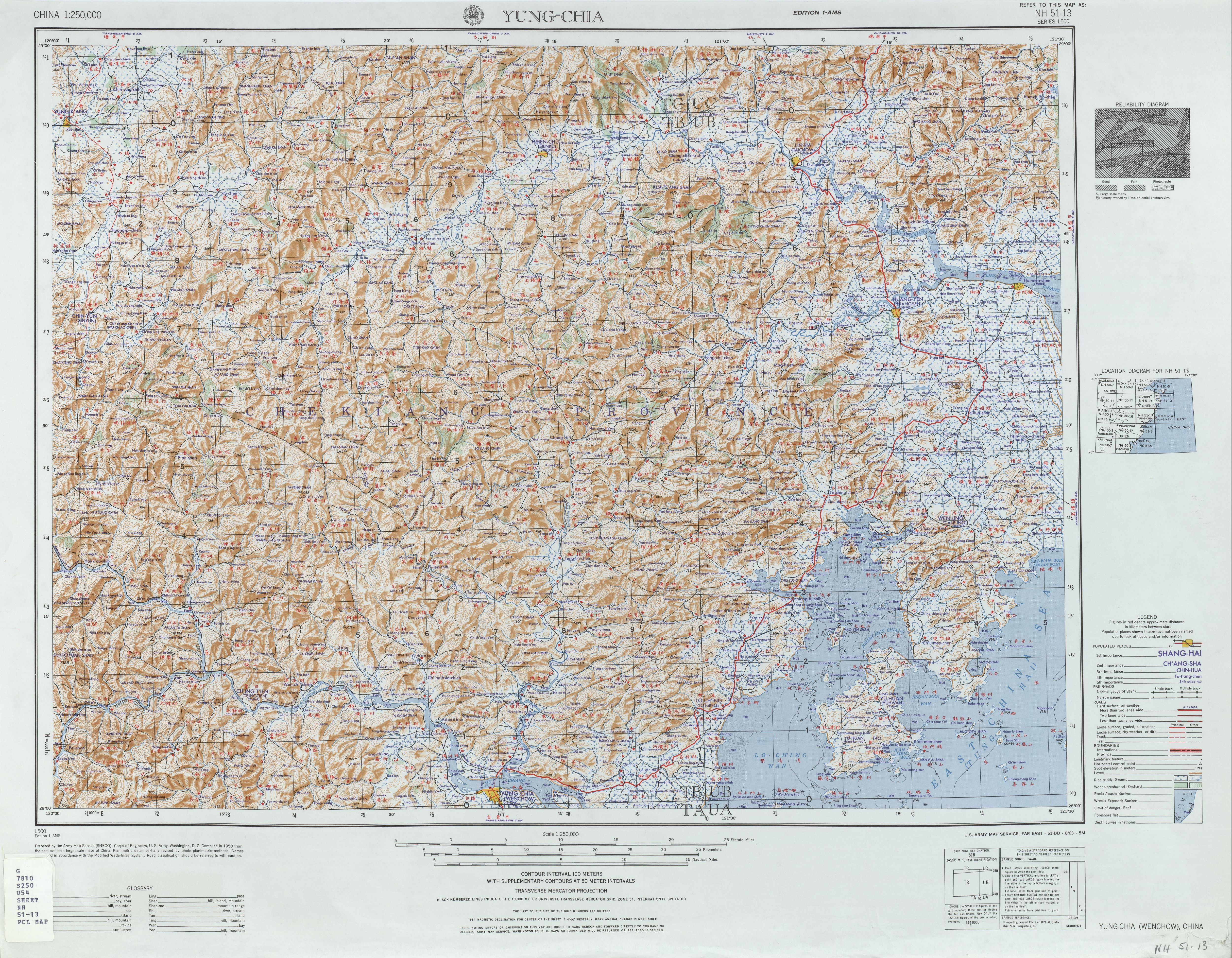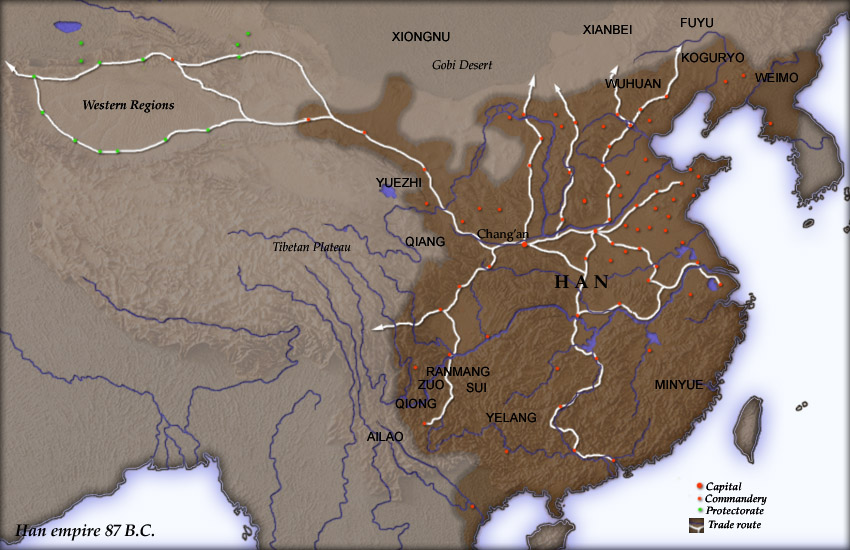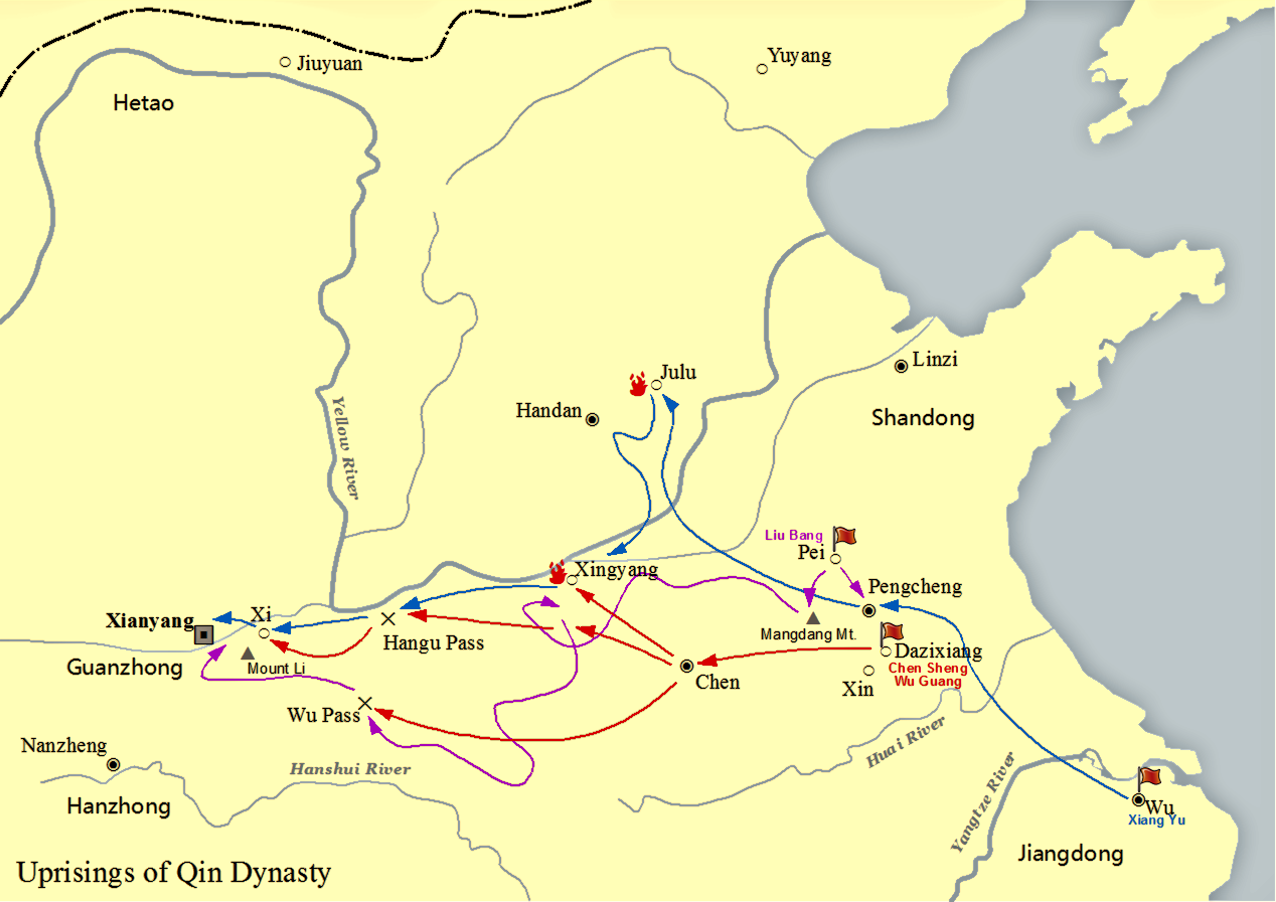|
Dong'ou
Dong'ou () also known as Ouyue (), was an ancient kingdom in modern Wenzhou and Taizhou, Zhejiang Province, China. The realm of Dong'ou was given to Zou Yao by Emperor Gaozu of Han in 192 BC. During the Han campaigns against Minyue in 138 BC, the king of Dong'ou no longer wished to live in his realm after the incident, and had all his people moved into the Han dynasty The Han dynasty (, ; ) was an imperial dynasty of China (202 BC – 9 AD, 25–220 AD), established by Liu Bang (Emperor Gao) and ruled by the House of Liu. The dynasty was preceded by the short-lived Qin dynasty (221–207 BC) and a warr .... References Further reading * * * * 138 BC 191 BC 190s BC establishments 2nd-century BC disestablishments 2nd-century BC establishments Former countries in Chinese history History of Zhejiang States and territories established in the 2nd century BC {{China-hist-stub ... [...More Info...] [...Related Items...] OR: [Wikipedia] [Google] [Baidu] |
Minyue
Minyue () was an ancient kingdom in what is now the Fujian province in southern China. It was a contemporary of the Han dynasty, and was later annexed by the Han empire as the dynasty expanded southward. The kingdom existed approximately from 334 BC to 110 BC. History Both Minyue and Dong'ou were founded by the royal Zou family who fled Yue after being defeated by Chu and Qi in 334 BC. When the Qin dynasty fell in 206 BC, the Hegemon-King Xiang Yu did not make Zou Wuzhu and Zou Yao kings. For that reason they refused to support him and instead joined Liu Bang in attacking Xiang Yu. When Liu Bang won the war in 202 BC, he made Zou Wuzhu king of Minyue and in 192 BC, he made Zou Yao king of Dong'ou (Eastern Ou). In 154 BC, Liu Pi King of Wu, revolted against the Han and tried to persuade Minyue and Dong'ou to join him. The king of Minyue refused but Dong'ou sided with the rebels. However when Liu Pi was defeated and fled to Dong'ou, they killed him to appease the Han, and t ... [...More Info...] [...Related Items...] OR: [Wikipedia] [Google] [Baidu] |
Wenzhou
Wenzhou (pronounced ; Wenzhounese: Yuziou �y33–11 tɕiɤu33–32 ), historically known as Wenchow is a prefecture-level city in southeastern Zhejiang province in the People's Republic of China. Wenzhou is located at the extreme south east of Zhejiang Province with its borders connecting to Lishui on the west, Taizhou on the north, and Fujian to the south. It is surrounded by mountains, the East China Sea, and 436 islands, while its lowlands are almost entirely along its East China Sea coast, which is nearly in length. Most of Wenzhou's area is mountainous as almost 76 percent of its surface area is classified as mountains and hills. It is said that Wenzhou has 7/10 mountains, 1/10 water, and 2/10 farmland. At the time of the 2010 Chinese census, 3,039,500 people lived in Wenzhou's urban area; the area under its jurisdiction (which includes three satellite cities and six counties) held a population of 9,122,100 of which 31.16% are non-local residents from outside of Wenz ... [...More Info...] [...Related Items...] OR: [Wikipedia] [Google] [Baidu] |
Taizhou, Zhejiang
Tāizhōu (pronunciation in PRC Standard Mandarin: , Taizhou dialect: Thecieu), alternately known as Taichow, is a city located at the middle of the East China Sea coast of Zhejiang province. It is located south of Shanghai and southeast of Hangzhou, the provincial capital. It is bordered by Ningbo to the north, Wenzhou to the south, and Shaoxing, Jinhua, and Lishui to west. In addition to the municipality itself, the prefecture-level city of Taizhou includes 3 districts, 3 county-level cities, and 3 counties. As of the 2020 census, its total population was 6,662,888 inhabitants whom 3,578,660 lived in the built-up (''or metro'') area made of the three urban Districts and Wenling City now being largely conurbated. Etymology Taizhou's name is believed to derive from nearby Mount Tiantai. History Five thousand years ago, the ancestors of the modern inhabitants began to settle in this area. During the Xia, Shang, and Zhou dynasties, when the Chinese state was largely confin ... [...More Info...] [...Related Items...] OR: [Wikipedia] [Google] [Baidu] |
Han Campaigns Against Minyue
The Han campaigns against Minyue were a series of three Han military campaigns dispatched against the Minyue state. The first campaign was in response to Minyue's invasion of Eastern Ou in 138 BC. In 135 BC, a second campaign was sent to intervene in a war between Minyue and Nanyue. After the campaign, Minyue was partitioned into Minyue, ruled by a Han proxy king, and Dongyue. Dongyue was defeated in a third military campaign in 111 BC and the former Minyue territory was annexed by the Han Empire. Background The Qin dynasty's military incursions in the south of what is now China began a period of expansion that continued under the next dynasty, the Han. After the fall of the Qin, Minyue was established in 202 BC, and Eastern Ou in 192 BC, with the support of the Han. They were rewarded with greater autonomy in return for their contributions to the revolt against the Qin. The local rulers of the Minyue region had also sided with Liu Bang's Han instead of Xia ... [...More Info...] [...Related Items...] OR: [Wikipedia] [Google] [Baidu] |
China
China, officially the People's Republic of China (PRC), is a country in East Asia. It is the world's most populous country, with a population exceeding 1.4 billion, slightly ahead of India. China spans the equivalent of five time zones and borders fourteen countries by land, the most of any country in the world, tied with Russia. Covering an area of approximately , it is the world's third largest country by total land area. The country consists of 22 provinces, five autonomous regions, four municipalities, and two Special Administrative Regions (Hong Kong and Macau). The national capital is Beijing, and the most populous city and financial center is Shanghai. Modern Chinese trace their origins to a cradle of civilization in the fertile basin of the Yellow River in the North China Plain. The semi-legendary Xia dynasty in the 21st century BCE and the well-attested Shang and Zhou dynasties developed a bureaucratic political system to serve hereditary monarchies, or dyna ... [...More Info...] [...Related Items...] OR: [Wikipedia] [Google] [Baidu] |
Ancient Chinese States
Ancient Chinese states () were typified by variously sized city-states and territories that existed in China prior to its unification by Qin Shi Huang in 221 BCE. In many cases these were vassal states and fiefs established in the '' fengjian'' system characterized by tributes paid to the ruling Zhou dynasty (1046–256 BCE). Such states and fiefs would again emerge during later dynasties as a political expedient when required. Rulers of these states were known as ''zhuhou'' (). Background According to the sinocentric viewpoint and the Mandate of Heaven, China was the center of the world and the incumbent emperor its only ruler; all other would-be potentates and rulers were merely vassals of the Middle Kingdom. As a result, from the earliest times the Chinese viewed the world as a series of concentric spheres of influence emanating outward from their capital. Within the closest circle lay the vassal states who pledged allegiance to the Zhou ruler. Apart from the Zhou dynasty ... [...More Info...] [...Related Items...] OR: [Wikipedia] [Google] [Baidu] |
Zhejiang
Zhejiang ( or , ; , also romanized as Chekiang) is an eastern, coastal province of the People's Republic of China. Its capital and largest city is Hangzhou, and other notable cities include Ningbo and Wenzhou. Zhejiang is bordered by Jiangsu and Shanghai to the north, Anhui to the northwest, Jiangxi to the west and Fujian to the south. To the east is the East China Sea, beyond which lies the Ryukyu Islands. The population of Zhejiang stands at 64.6 million, the 8th highest among China. It has been called 'the backbone of China' due to being a major driving force in the Chinese economy and being the birthplace of several notable persons, including the Chinese Nationalist leader Chiang Kai-shek and entrepreneur Jack Ma. Zhejiang consists of 90 counties (incl. county-level cities and districts). The area of Zhejiang was controlled by the Kingdom of Yue during the Spring and Autumn period. The Qin Empire later annexed it in 222 BC. Under the late Ming dynasty and the Qing ... [...More Info...] [...Related Items...] OR: [Wikipedia] [Google] [Baidu] |
Emperor Gaozu Of Han
Emperor Gaozu of Han (256 – 1 June 195 BC), born Liu Bang () with courtesy name Ji (季), was the founder and first emperor of the Han dynasty, reigning in 202–195 BC. His temple name was "Taizu" while his posthumous name was Emperor Gao, or Gaodi; "Gaozu of Han", derived from the ''Records of the Grand Historian'', is the common way of referring to this sovereign even though he was not accorded the temple name "Gaozu", which literally means "High Founder". Liu Bang was one of the few dynasty founders in Chinese history who was born into a peasant family. Prior to coming to power, Liu Bang initially served for the Qin dynasty as a minor law enforcement officer in his home town Pei County, within the conquered state of Chu. With the First Emperor's death and the Qin Empire's subsequent political chaos, Liu Bang renounced his civil service position and became an anti-Qin rebel leader. He won the race against fellow rebel leader Xiang Yu to invade the Qin heartlan ... [...More Info...] [...Related Items...] OR: [Wikipedia] [Google] [Baidu] |
Han Dynasty
The Han dynasty (, ; ) was an imperial dynasty of China (202 BC – 9 AD, 25–220 AD), established by Liu Bang (Emperor Gao) and ruled by the House of Liu. The dynasty was preceded by the short-lived Qin dynasty (221–207 BC) and a warring interregnum known as the ChuHan contention (206–202 BC), and it was succeeded by the Three Kingdoms period (220–280 AD). The dynasty was briefly interrupted by the Xin dynasty (9–23 AD) established by usurping regent Wang Mang, and is thus separated into two periods—the Western Han (202 BC – 9 AD) and the Eastern Han (25–220 AD). Spanning over four centuries, the Han dynasty is considered a golden age in Chinese history, and it has influenced the identity of the Chinese civilization ever since. Modern China's majority ethnic group refers to themselves as the "Han people", the Sinitic language is known as "Han language", and the written Chinese is referred to as "Han characters". The emperor was at the pinnacle of ... [...More Info...] [...Related Items...] OR: [Wikipedia] [Google] [Baidu] |
138 BC
__NOTOC__ Year 138 BC was a year of the pre-Julian Roman calendar. At the time it was known as the Year of the Consulship of Serapio and Callaicus (or, less frequently, year 616 ''Ab urbe condita'') and the Third Year of Jianyuan. The denomination 138 BC for this year has been used since the early medieval period, when the Anno Domini calendar era became the prevalent method in Europe for naming years. Events By place Roman Empire * Tautalus surrenders to the Romans. * Valencia in Spain is founded as a Roman colony. Asia Minor * Attalus III succeeds Attalus II as Attalid king of Pergamon Egypt * Galaestes revolts. Syria * Antiochus VII expels Diodotus Tryphon. * Tryphon sacks Beirut Parthia * Phraates II becomes emperor of Parthia. China * Grand Empress Dowager Dou, the grandmother of Emperor Wu of Han, purges the high administration of officials to consolidate her power. Among those dismissed are Prime Minister Dou Yong and her own half-brother, the General-in-Chi ... [...More Info...] [...Related Items...] OR: [Wikipedia] [Google] [Baidu] |
191 BC
__NOTOC__ Year 191 BC was a year of the pre-Julian Roman calendar. At the time it was known as the Year of the Consulship of Nasica and Glabrio (or, less frequently, year 563 ''Ab urbe condita''). The denomination 191 BC for this year has been used since the early medieval period, when the Anno Domini calendar era became the prevalent method in Europe for naming years. Events By place Roman Republic * The Romans under Manius Acilius Glabrio and Cato the Elder cut the Seleucid king Antiochus III off from his reinforcements in Thrace and outflank his position at the pass of Thermopylae in the Battle of Thermopylae. With the remainder of his troops, Antiochus flees to Chalcis on Euboea and from there he retreats by sea to Ephesus. * Manius Acilius Glabrio then turns his attention to the Aetolian League, which has persuaded Antiochus to declare war against Rome, and is only prevented from crushing them by the intercession of Titus Quinctius Flamininus. * Scipio Africanus pers ... [...More Info...] [...Related Items...] OR: [Wikipedia] [Google] [Baidu] |
190s BC Establishments
Nineteen or 19 may refer to: * 19 (number), the natural number following 18 and preceding 20 * one of the years 19 BC, AD 19, 1919, 2019 Films * ''19'' (film), a 2001 Japanese film * ''Nineteen'' (film), a 1987 science fiction film Music * 19 (band), a Japanese pop music duo Albums * ''19'' (Adele album), 2008 * ''19'', a 2003 album by Alsou * ''19'', a 2006 album by Evan Yo * ''19'', a 2018 album by MHD * ''19'', one half of the double album ''63/19'' by Kool A.D. * ''Number Nineteen'', a 1971 album by American jazz pianist Mal Waldron * ''XIX'' (EP), a 2019 EP by 1the9 Songs * "19" (song), a 1985 song by British musician Paul Hardcastle. * "Nineteen", a song by Bad4Good from the 1992 album ''Refugee'' * "Nineteen", a song by Karma to Burn from the 2001 album ''Almost Heathen''. * "Nineteen" (song), a 2007 song by American singer Billy Ray Cyrus. * "Nineteen", a song by Tegan and Sara from the 2007 album '' The Con''. * "XIX" (song), a 2014 song by Slipknot. ... [...More Info...] [...Related Items...] OR: [Wikipedia] [Google] [Baidu] |



%2C_King_of_Wuyue.jpg)

